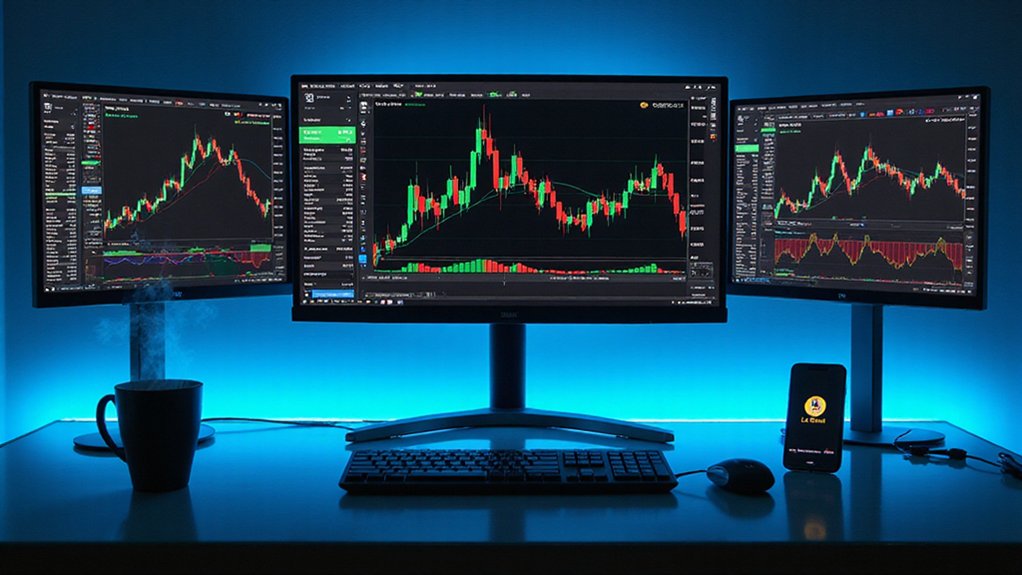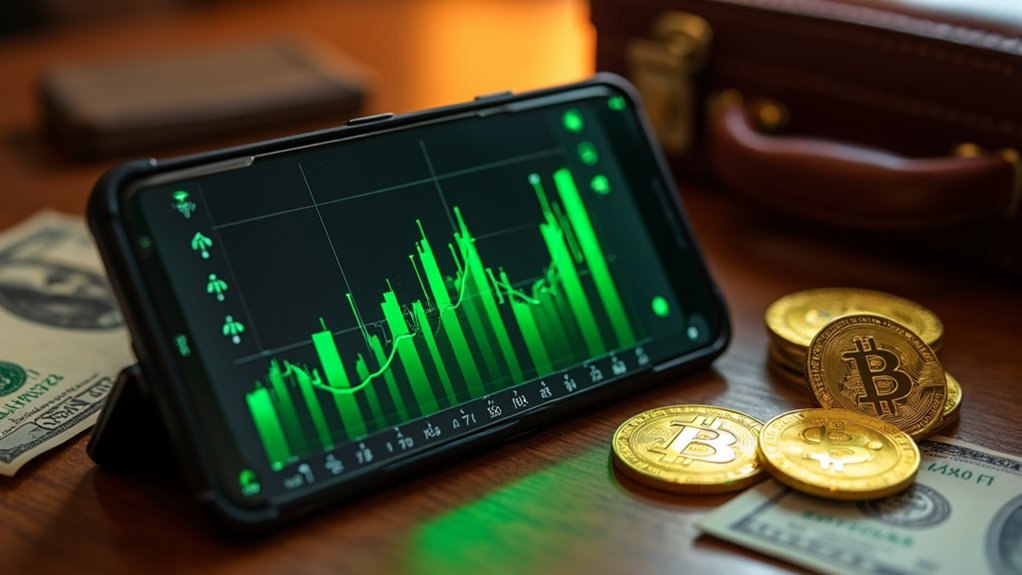Coinbase Exchange offers traders a robust platform accessible via Advanced Trade and Exchange interfaces, supporting diverse asset pairs through Market, Bracket, and Iceberg orders. With order book depth tripling in Q1 2025 and perpetual futures expanding from 15 to 106 offerings, the platform balances sophisticated tools with regulatory compliance. The revamped Quoting Program empowers market makers, while decreasing Bitcoin volatility signals market maturation. The exchange’s commitment to listing 50-80 new tokens promises ample opportunity for the strategically inclined trader.

The digital asset marketplace continues to evolve at a breakneck pace, and Coinbase Exchange stands as one of the towering pillars in this rapidly shifting landscape.
Traders access its Central Order Book platform via Coinbase Advanced Trade and Coinbase Exchange interfaces, where they can execute transactions across a diverse array of digital asset and fiat currency pairs.
The platform’s versatility manifests in its support for various order types—from straightforward Market Orders to more nuanced instruments like Bracket Orders and Iceberg variants (the latter being particularly useful for those who prefer their trading intentions remain somewhat obscured from market observers).
Advanced traders find refuge in Coinbase’s Iceberg Orders, where strategic intention meets tactical obscurity in today’s transparent markets.
Order placement necessitates sufficient balance coverage—a rather obvious requirement, yet one that catches newcomers unawares with surprising frequency.
Once placed, orders subject the relevant assets to holds until filled or canceled, though Maker and Stop Orders can be rescinded without incurring fees.
Coinbase’s Q1 2025 performance metrics reveal impressive growth, with average order book depth increasing nearly threefold since Q4 2024 across major cryptocurrencies—a development that enhances execution quality substantially.
The exchange’s liquidity initiatives have proven remarkably effective, with a revamped Quoting Program empowering market makers to deepen liquidity pools.
While Coinbase focuses on spot trading, competitors like Deribit have captured significant market share by offering European-style options and up to 50x leverage for derivatives traders.
Their Request for Quote feature guarantees seamless execution even for larger orders—no small consideration for institutional participants handling these volatile waters.
Market conditions have become increasingly favorable for traders as Bitcoin’s volatility decreased from 70% during 2020-22 to below 50% after 2023, creating a more stable environment for executing trades.
The platform offers a variety of sophisticated investment strategies and tools reflecting the maturity of crypto markets that have evolved over recent years.
Looking forward, Coinbase has ambitious plans to list between 50-80 new tokens in the first half of 2025, implementing faster listing methodologies to capitalize on emerging opportunities.
Regulatory compliance remains central to Coinbase’s operation; the exchange works diligently with regulators to expand access while guaranteeing trading activities meet stringent requirements.
This positioning has cemented Coinbase International Exchange as a leader in the global crypto derivatives market, with particularly impressive growth in perpetual futures listings—expanding from a mere 15 to 106 offerings, with total open interest reaching all-time highs.
The derivatives landscape, once dominated by offshore entities of questionable regulatory standing, increasingly finds its center of gravity shifting toward more compliant operations like Coinbase.
Frequently Asked Questions
How Does Coinbase Handle Security During Network Outages?
During network outages, Coinbase maintains security through a multi-layered approach.
The exchange stores 98% of assets in cold storage—immune to online threats by definition—while continuously monitoring network activity for anomalies.
Their redundant power and hardware systems prevent cascading failures, and strict access controls remain enforced regardless of operational status.
The platform’s AES-256 encryption protocols persist through downtime, safeguarding user data even when trading capabilities are temporarily compromised.
Can I Automate Trades Using Third-Party APIS?
Yes, traders can automate their Coinbase activities using third-party platforms like 3Commas, Bitsgap, Altrady, and Cryptohopper.
These integrations require creating API keys with specific permissions, enabling features such as concurrent take-profit/stop-loss orders and strategy customization based on technical indicators.
While offering sophisticated automation capabilities that transcend Coinbase’s native interface limitations, users should exercise due diligence regarding security—an ironic reality where convenience necessitates additional vigilance in the cryptosphere.
What Taxes Apply to Cryptocurrency Trading Profits?
Cryptocurrency trading profits trigger two primary tax obligations: capital gains tax (long-term for assets held over a year at 0-20% rates; short-term for quicker flips at ordinary income rates of 10-37%) and income tax for mining, staking, or airdrops.
The IRS, unsurprisingly vigilant about this digital frontier, requires reporting of all transactions—regardless of whether traders find the regulatory framework appropriate for an asset class designed to circumvent traditional financial infrastructure¹.
¹The irony of applying century-old tax principles to blockchain technology isn’t lost on most traders.
How Do Coinbase Fees Compare to Other Major Exchanges?
Coinbase’s fee structure runs decidedly higher than competitors—particularly for retail traders.
While sophisticated investors can access maker fees as low as 0% (compared to Binance’s baseline 0.10%), Coinbase’s taker fees reach up to 0.60%, substantially exceeding alternatives.
The platform shines with free USDC-USD conversions up to $40 million monthly and competitive crypto withdrawal costs, but its complex tiered system and relatively steep wire withdrawal fees ($25) make it less economical than Binance or Crypto.com for casual traders.
Is Staking Available for All Cryptocurrencies on Coinbase?
No, staking is not available for all cryptocurrencies on Coinbase.
The platform offers staking services only for select assets like Ethereum (ETH), Solana (SOL), and USDC.
Conspicuously absent from the eligibility list is Bitcoin—the cryptocurrency market’s behemoth.
Each stakeable asset comes with its own requirements and reward structures, with returns varying considerably (up to 14% in some cases).
Users must hold these specific assets in their Coinbase account to participate in the blockchain validation process.









